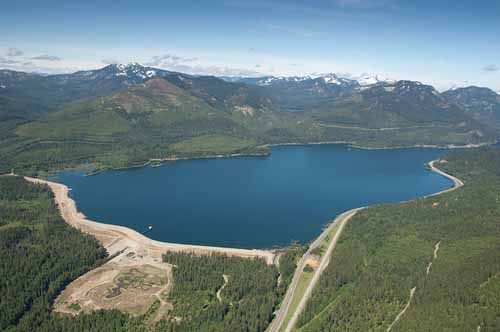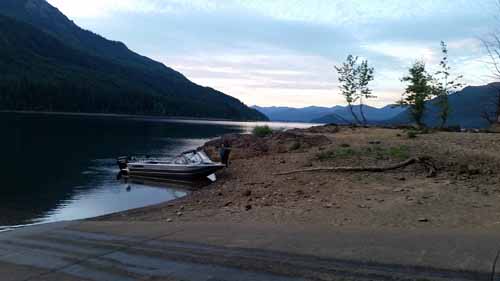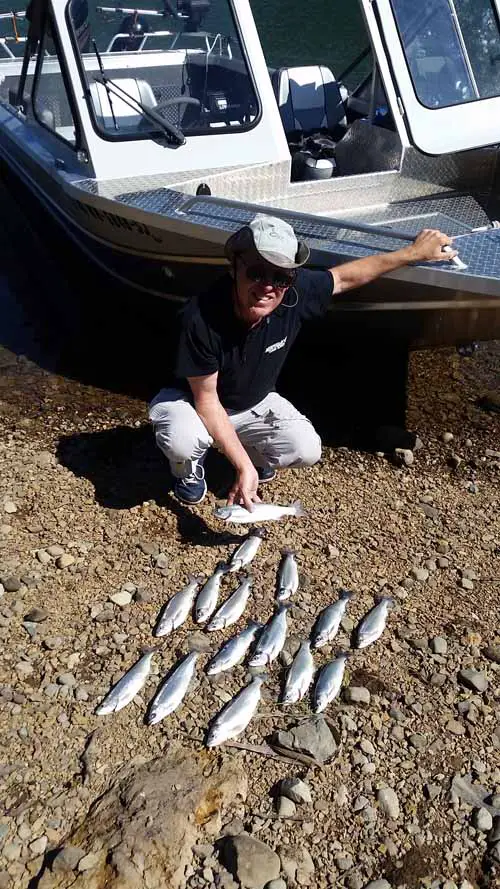Search
Latest Articles
Alpine Kokanee Trifecta
by Mike Carey, September 01, 2016
The Alpine Kokanee Trifecta I speak of is familiar to many, but passed by with a reputation of having small kokanee. I’m here to tell you, that is a myth. While it’s true you won’t find those 20” koks, you will find fish that range from 10” up to 14”. The lakes I’m referring to?
Keechelus, Kachess, and Cle Elum. Yup, that first big reservoir as you crest Snoqualmie Pass going east is one of three Alpine Kokanee Lakes that I think you should make plans to visit. Let’s look at them one by one, going from west to east.
Keechelus Reservoir
This lake is the one that we all gaze at as we are driving somewhere else. It’s also the one that come August turns into a giant stump field. At 2,408 acres, it’s the smallest of the three lakes. At 2,521 feet of elevation it’s also the highest of the three lakes. The lake holds rainbow, cutthroat, whitefish, bull trout (which are endangered and are to be carefully released), burbot, and kokanee. Of the three lakes we will look at, this lake probably has the smallest kokanee in it. But check this out – the 2016 stocking numbers for this lake were a whopping 256,892 kokanee! In 2015 it was 265,000 and in 2014 it was 238,000 kokanee. So bottom line, that’s a lot of kokanee swimming around waiting to be caught!

Here’s the catch (there’s always a catch, right?). This reservoir gets drawn down as the summer progresses. Seriously drawn down, as in not able to launch a boat drawn down. So if you want to fish the Trifecta next year, you’d best plan on hitting this lake first. The primary boat launch is found on the west end of the lake. The earthen dam is on the far east end of the lake. Be aware, this lake, perhaps worst of the three, is prone to heavier wind and whitecaps. Be prepared to get back to the launch if the wind picks up. The lake is also the least serene of the three lakes as the constant hum of the freeway and view of semis roaring past are a sharp contrast to the beautiful surrounding mountains. This lake is a one pole only lake.

Kachess Reservoir
If you’re looking for a beautiful camping location with stunning scenery this is your lake. The Kachess Forest Service Campground is one of the nicer ones around. Plenty of camping spots and some larger pull through sites make it “boat friendly”. The restrooms are - surprise – running water and flush toilets! The boat launch is a two lane concrete ramp with nice grade and plenty of surrounding shoreline to pull your boat up on. Winds can be an issue as it’s not in a sheltered location. Parking is good.

Like Keechelus, Kachess holds a nice variety of fish. Rainbow, cutthroat, bull trout (protected), whitefish and burbot can all be found in addition to the kokanee. As to kokanee stocking, in 2014 WDFW stocked 365,000 fish, 2015 490,000, and for 2016 413,098. You’ll get into the kokanee as soon as you launch the boat. Motor out a hundred yards and watch as your depth finder shows the bottom dropping to 180 feet and deeper. And then you’ll see your fish finder light up with kokanee arches 35 to 80 feet deep. You’ll find fish all the way the length of the lake down to the dam end, over four miles away. But beware, if you head north the lake shallows up at a choke point north of the launch and you’ll find yourself in ten feet of water.

On our most recent trip, we found a great early morning bite that turned off at 8:30am. After an hour of fruitless trolling we ran all the way down to the dam and were rewarded with good action the rest of the morning. Don’t be afraid to leave non-biting fish in search of the biters! On this trip we also caught and safely released a powerful 16” bull trout. What a thrilling fight on kokanee gear. We hooked him at 55 feet deep on the downrigger. To help protect these beautiful fish bring a knotless net.
Kachess is 4,377 acres and an elevation of 2,258 feet.

Cle Elum Reservoir
The final gem of our trifecta is Cle Elum reservoir. Although the farthest of the three lakes, it’s still a day trip for the Seattle area angler. Cle Elum also has a Forest Service campsite and nice paved launch (an old road, actually). Not as nice as Kachess, but the scenery is again spectacular and there is no freeway sound to ruin the experience. Cle Elum also has the nearby town of Roslyn to grab provisions and a nice dinner at the end of your day of fishing.
Cle Elum is the largest of the three reservoirs at 4,566 acres. It’s the lowest lake, at 2,227 acres. As the summer water draw down lowers the lake, the ramp becomes high and dry. Boaters then will launch among the stumps at the southeast side of the lake by the dam. Watch your props and winds out of the north as this can be a risky proposition.
The lake holds the same species as our other two lakes with a notable and significant difference. First there is Mackinaw trout in the lake.
These fish are on WDFW and the Yakima Tribe’s radar screen to remove from the lake. Why, you may ask, when some dandy lakers up to 15 pounds and more have been caught? Well, in the (hopefully) not too distant future Cle Elum may join Baker and Wenatchee lakes as a destination sockeye fishery. That’s right; the Yakima Tribe has been working since 2009 to restore a sockeye run to Lake Cle Elum. It works like this: the sockeye are captured at Priest Rapids dam and transferred to the lake. They then run up the Cle Elum River and spawn. When the fish hatch, they spend 1-2 years in the lake and then leave the lake via a flue around an earthen dam to the Yakima River. From the Yakima River, they will swim to the Columbia, and traveling on another 330 miles, around four Columbia River dams, to the Pacific Ocean.
Here’s more information from the Yakima Nation Fisheries website:
“One thousand adult sockeye were transplanted in the summer of 2009, 2,500 in 2010, 4,500 in 2011, 10,000 in 2012 and 4,000 in 2013. The sockeye successfully spawned in tributaries above the Lake in all years becoming the first sockeye to spawn in the Yakima Basin in over 100 years. Juveniles from the 2009 brood were observed migrating downstream at Roza and Prosser Dams in 2011. Preliminary data from trapping operations at Prosser indicated a 2011 smolt outmigration of approximately 80,000 sockeye. From July - Oct. 2013, 701 Sockeye migrated to the Yakima River Basin (numbers reported at October 17, 2013). So far, 211 sockeye have migrated back home to the Yakima River Basin (updated July 1, 2014).Once these fish move north to Roza Dam they will be transported into Lake Cle Elum or Cle Elum River. So far, we have trapped and hauled 4,500 sockeye from Priest Rapids to Lake Cle Elum. We will continue to monitor fish run numbers and trap and haul accordingly (updated July 1, 2014).”
So where are the kokanee you may ask? Well, WDFW has stopped stocking Lake Cle Elum since this recovery process started. But that doesn’t mean you can’t catch kokanee.
According to a fisheries biologist I spoke with on the subject, some of the kokanee you catch are actually sockeye that have decided to not migrate back to the ocean. Instead, they spend their adult lives in lake Cle Elum, and then spawn as well in the Cle Elum River. In order to protect the sockeye in Cle Elum, WDFW has placed a slot limit of 9” to 15”on kokanee in Cle Elum. The limits are different on Cle Elum as well. As of 2016, Keechelus and Kachess had ten kokanee limits, and not including trout. Cle Elum has a five fish limit, including trout. Cle Elum is also the only lake of the three to allow the two pole endorsement. Finally, there is NO limit on lakers, brown, and eastern brook trout. WDFW wants these non-native species out of the lake to benefit juvenile sockeye salmon and encourages anglers to help in that effort. As always, be sure to check current regs for any updates.
There you have it. Three Alpine Lake Kokanee gems, all day trips from the greater Seattle region offer the angler spectacular scenery and fisheries that produce abundant (if not huge) kokanee. With gas prices at historical lows now is the time to plan a trip to these great destinations and leave the masses behind.
I will offer a couple words of caution for boating anglers. First, the winds blowing down the mountainsides on these three lakes can kick up and blow whitecaps, especially in the afternoon. So keep an eye on the weather and be ready to head back in if things start blowing. Second, if you troll with downriggers, be aware that these reservoirs may have trees sticking up from the bottom that didn't get clear cut. So be ready to bring those downrigger balls up fast!
See you on the water catching some tasty kokanee on these Alpine Lake Gems!





